As I am writing this article I am sitting aboard GEKKO, cozy leaning against the front bulkhead, it is warm and nice inside whilst outside a a quite remarkable wind is raging on. The plotter is still active and the TWS display seldom shows digits below 25, from time to time a 30 lets me raise my head, listen to the sound and makes me think back to some hours ago. That is when I arrived after the second leg of this maiden voyage of my new boat into Warnemuende, a marina I know very good from past trips. Nevertheless, this is special.
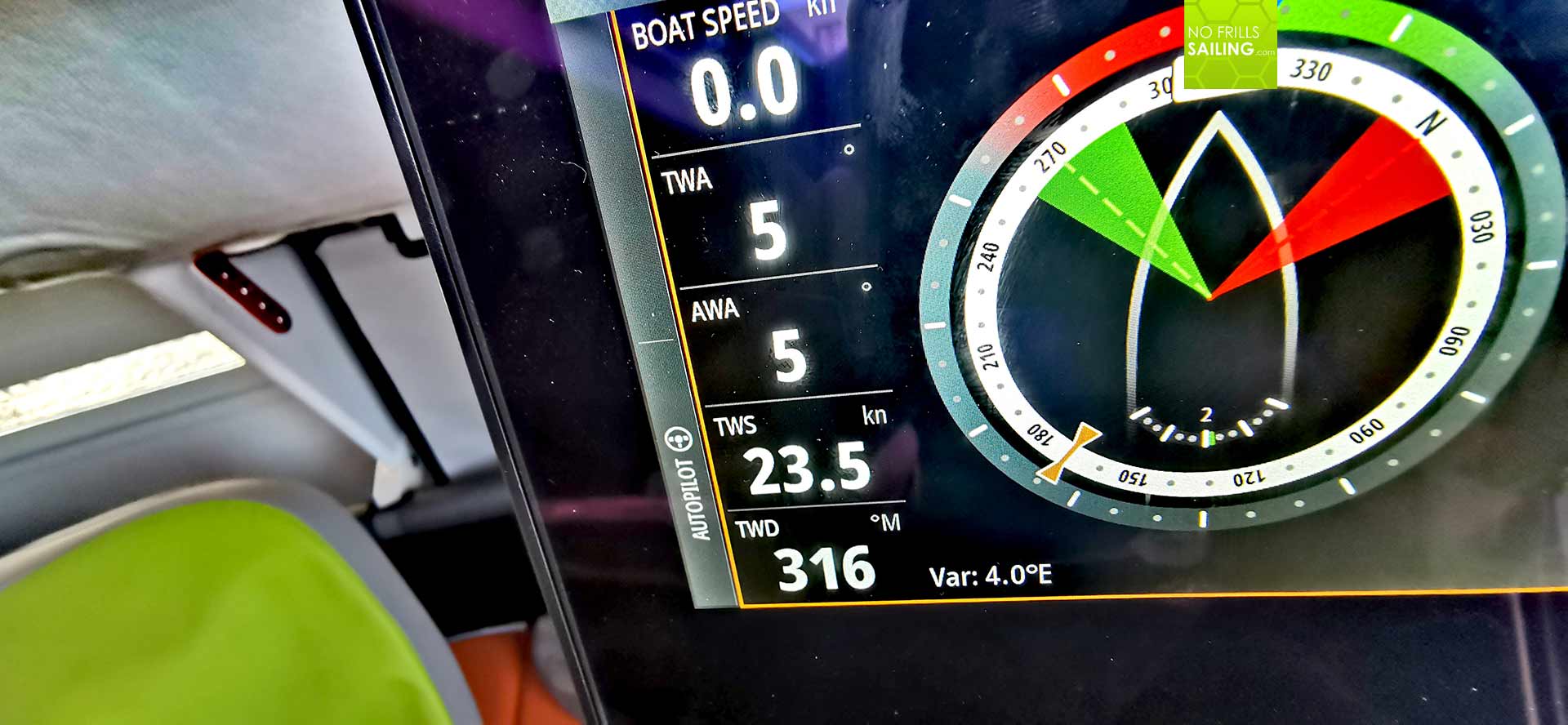
Special in so many ways: A maiden voyage in a brand new boat is always something that will have a dedicated place in every skipper´s logbook for sure, secondly, this is a single handed sailing trip and as such something completely new for me. Nobody to rely on, nobody to relate to, no other than myself aboard. What have I dreamt of this week before, all the questions which have made many nights sleepless. Now, that I am in the midst of it, I can´t hardly grasp it. First and foremost: I am a very, very, very happy man! But let´s start at the beginning.
Start with a mishap
Two days ago the clock on my smartphone rang and I got up. Wondering about the fact that there was such a bright daylight at this time: 0400 was my target time and casting off was set at 0500. Well, Herr Freud would have called it a classic – I had set the alarm to 0500 and that explains why the sun was up. No problem, I thought looking outside: No wind at all. That was expected, but a bit later so I figured that the forecast might have been a bit off that day. Instead of 0500 GEKKO let her lines go at 0530 after a nice hot coffee and some cereals. I left my home port and raised the main sail as the second mishap happened.
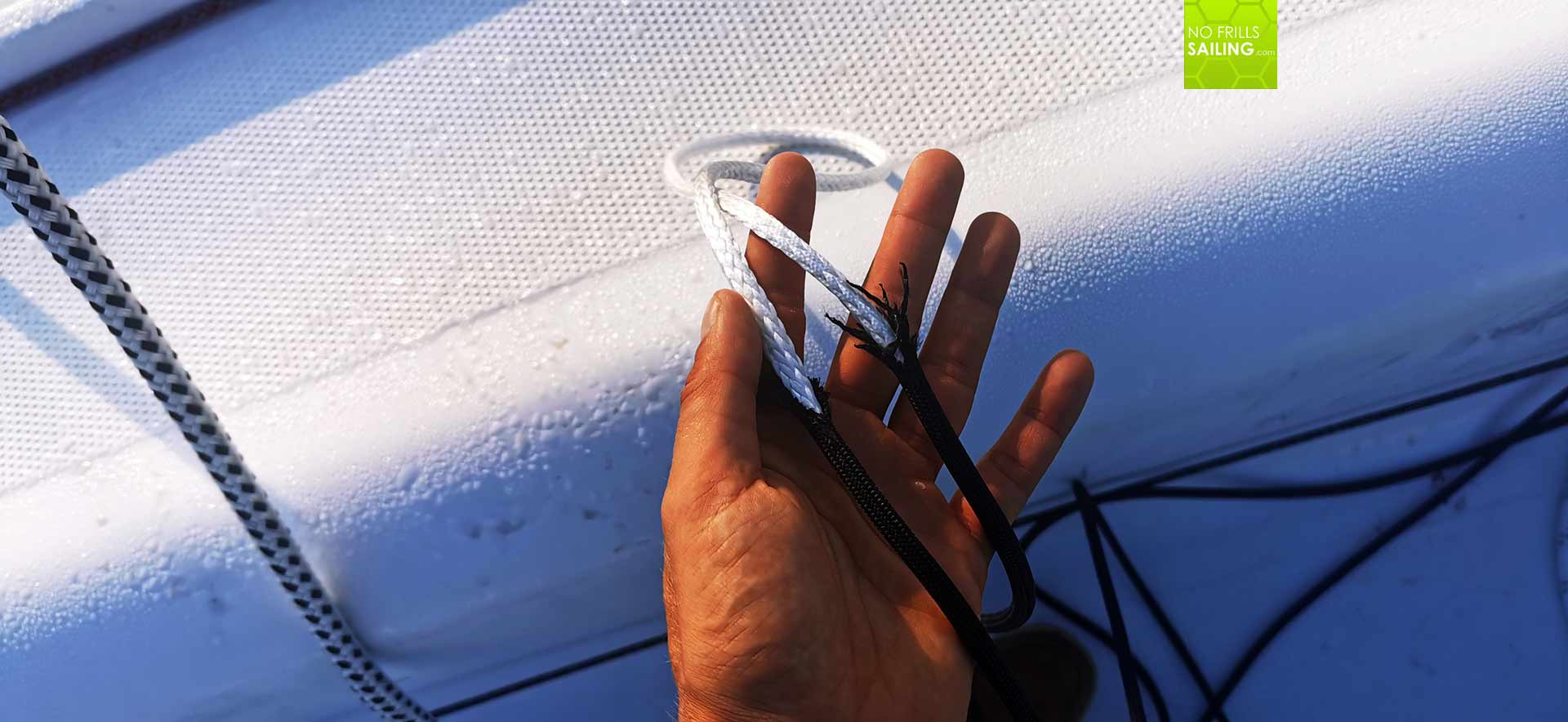
The outer garment of the mainsail halyard broke and the inner, softer white garment got exposed ofer a length of some 30 centimetres. No problem to say the least to get up the mainsail, which I did, deciding to cover that damage later. Wind was a bit more to the West than expected but it was also a lot less stronger, with only a puff of 5 knots. Still, enough to raise the Gennaker and at least the boat sailed under wind power with 2-3 knots SOG. Not much, not exciting but a slow start was expected.
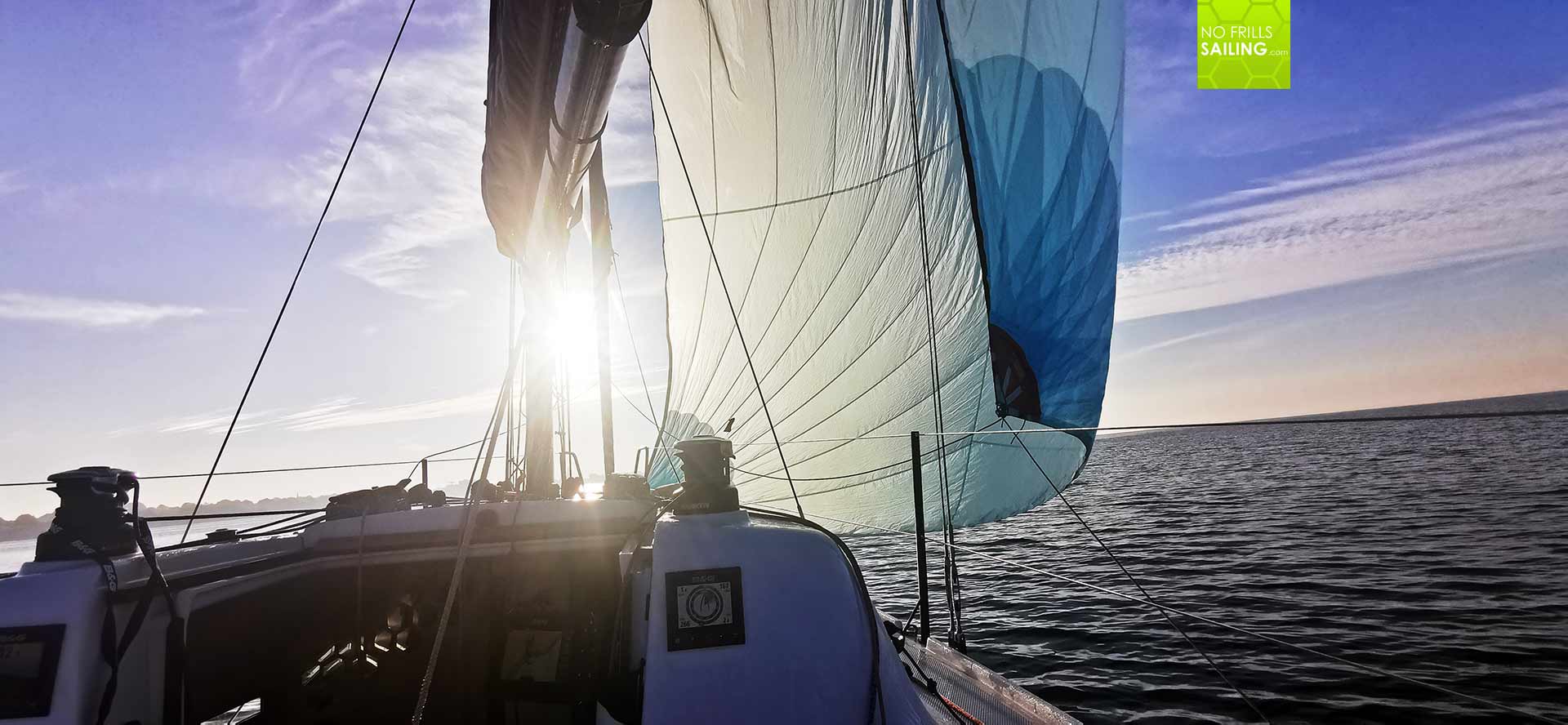
I tried to repair the broken mainsail halyard as best as I could. Covering the exposed parts with Gaffer tape trying to hold together the rope as a whole, I also hoped to prevent the outer garment from further detaching. Well, another thing on the “to repair”-list and definitely something I would have to keep an eye ono: A damaged mainsail halyard is no fun, especially when you do not have a seat to go into the mast top, let alone a spare rope.
A Sailor´s Ordeal
I was on the way and the GEKKO made slow progress. I know the Luebeck Bay area very well as my job has taken me out into this area so many times over again that I do not need to take a look onto the chart plotter to get a quite remarkable estimate in distances. We were slow, very slow. Nevertheless, I could practice a bit my skills in Gennaker-trimming and used the time to learn best I can.
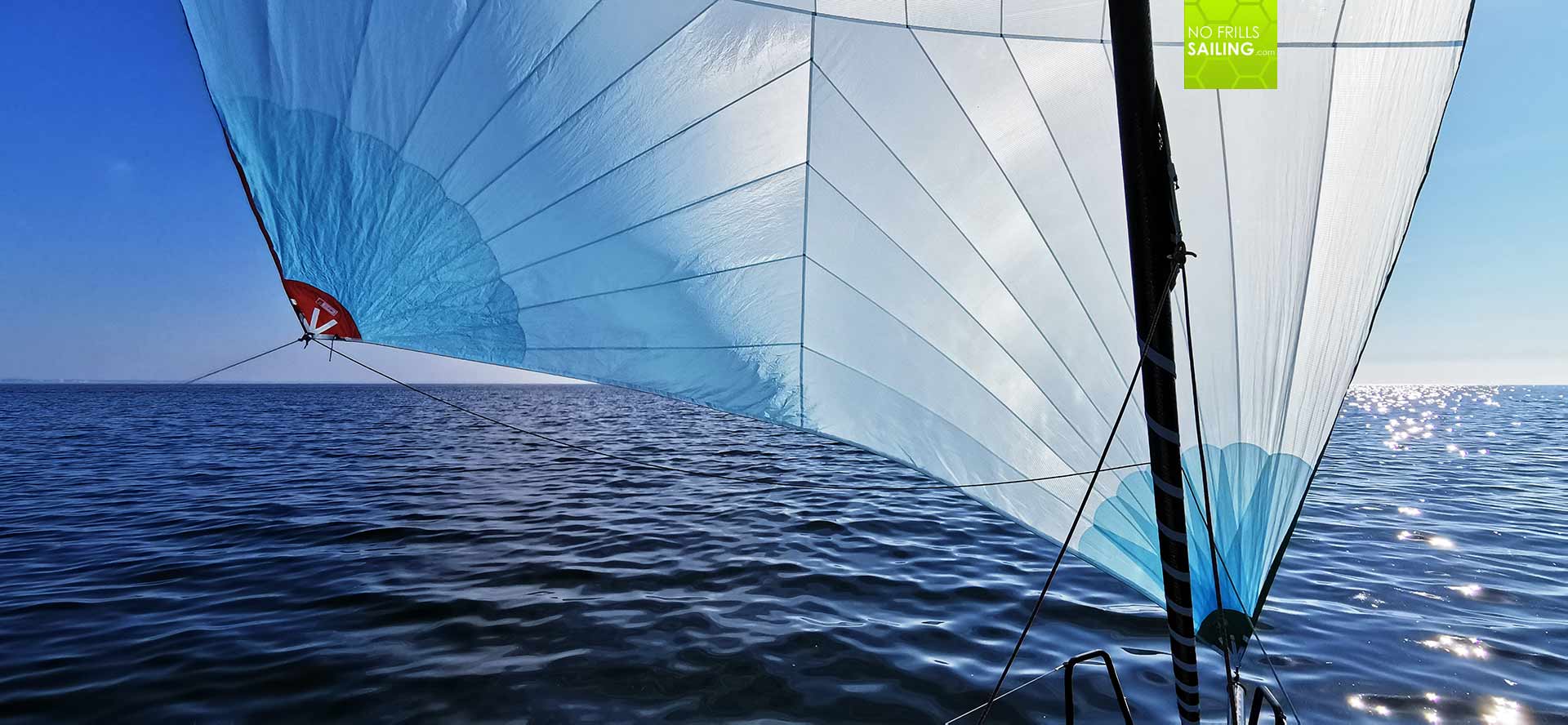
At 0800 the wind increased a bit – which was as forecasted – and the low puff became a little nice 8 knot-breeze. GEKKO sprun to life and for 2 hours – at least – the boat was quite fun to sail. Nevertheless, for hours and hours I was still able to see my home marina and the tall buildings of the Hotels all around Luebeck Bay area which was a bit nurturing frustration: I countered that raising feeling with telling myself: “This is holiday. Vacation. No regatta, no damn race. Take your time – this trip is under the motto ´Go where the wind is blowing you´ And so I sat down in the cockpit and relaxed.
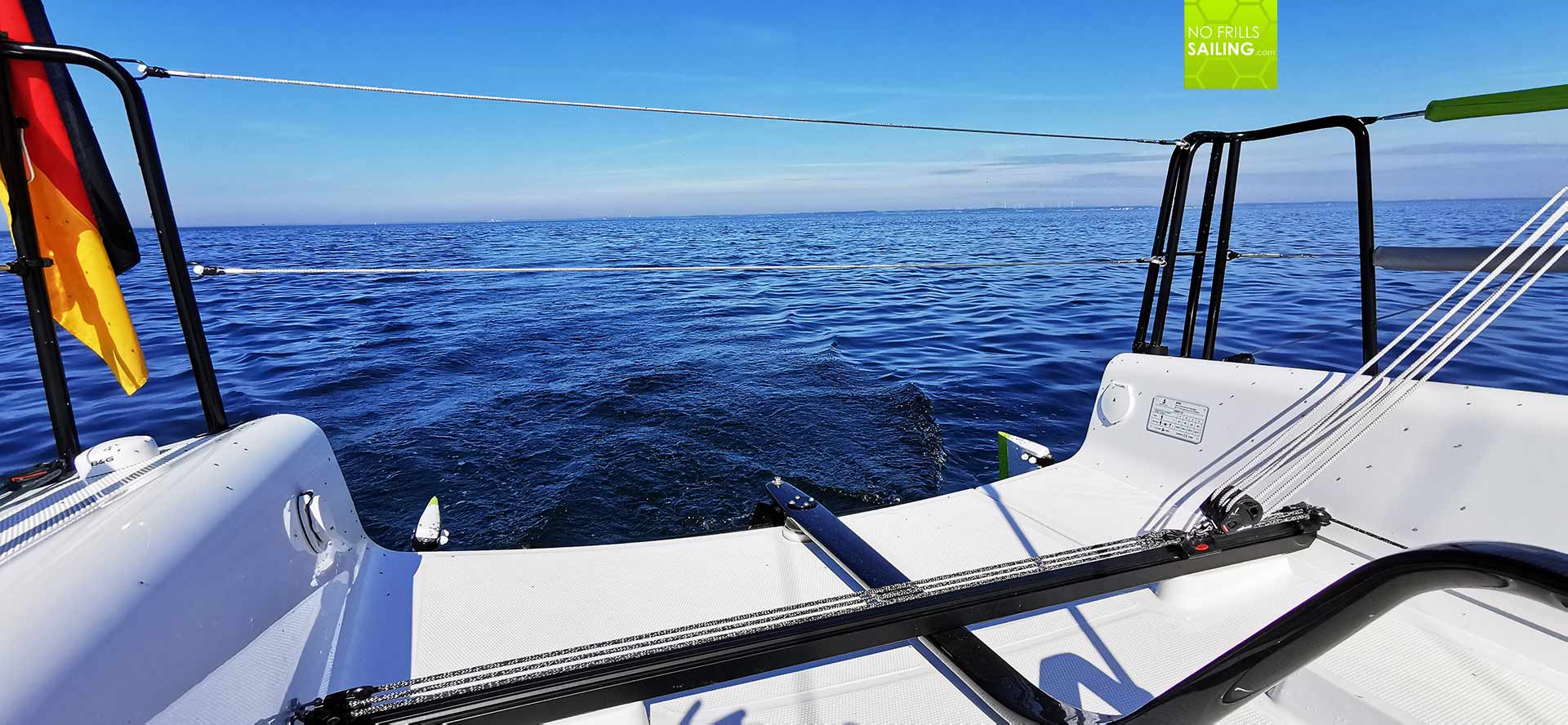
After such a long time working my ass off with our country slowly opening up after Covid-19 lockdowns I took it as a real reward: This clearly was my first real leisure in months. GEKKO sailed smoothly and the miles melted. The logbook notes that temps raised over 20 degrees Celsius, creaming myself with sunblocker, sitting down and being with just myself. Easy. Nice.
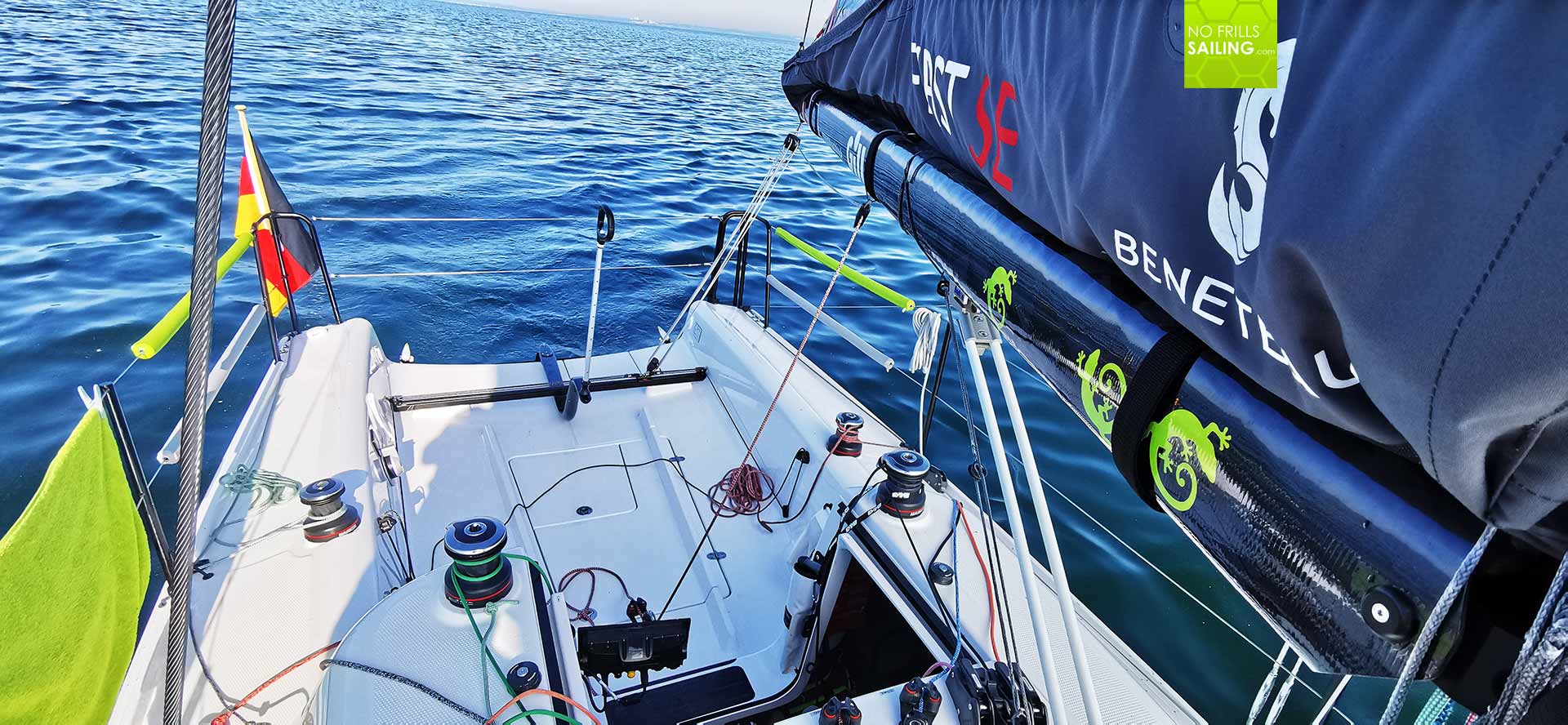
How could it have been getting better for a first vacational trip like this? What could I possibly been hoping for? The hustle of a 20 knot wind? Demanding upwind battles and violent rides in gusty blows? No, I thought, that might be the best start into the maiden voyage possible and I was thankful for that. One must be able to spend time alone, when alone. So, I took it the sportive way and tackle this low-wind ordeal
Low wind – long thoughts
Slowly changing course right where the wind was blowing was a new thing for me. Normally I would have set a target to reach, say harbour X or marina Y, and I would choose the shortest possible route – adjusting the sails accordingly. Well, not so today. The wind was so low that I rather had it filling the Gennaker sail from the most efficient angle than anything else. In this, the plotter showed the “dog curve” as I followed the wind, not a route.
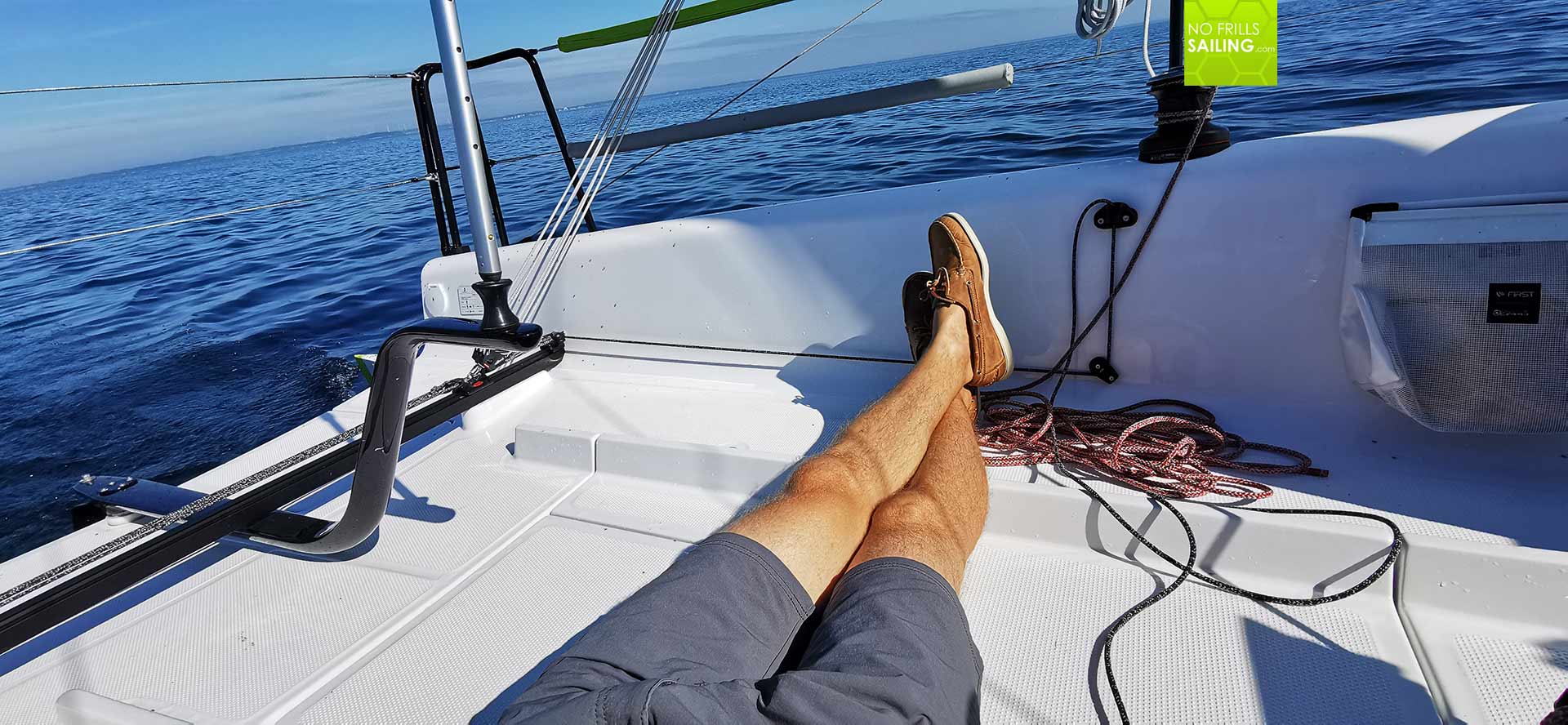
I loved it! Going down to make a coffee occasionally – a matter of a single minute thanks to the ultra-fast Jetboil cooker – or grab a fresh fruit from the provisions, I treated myself like a king. It was quiet and nice, just myself, the light sound of the wind and a slight murmur at the stern of the water flowing by. Time to think about sailing and being a skipper. I love sailing with people, but I also know about the dark sides: From occasional misunderstandings to getting accustomed to the specialties of other crew members up to the real threat of a mutiny, which I also had to go through four years ago, I know about boats being a “social ractor”. Not so with GEKKO: There simply is no crew. Just me.
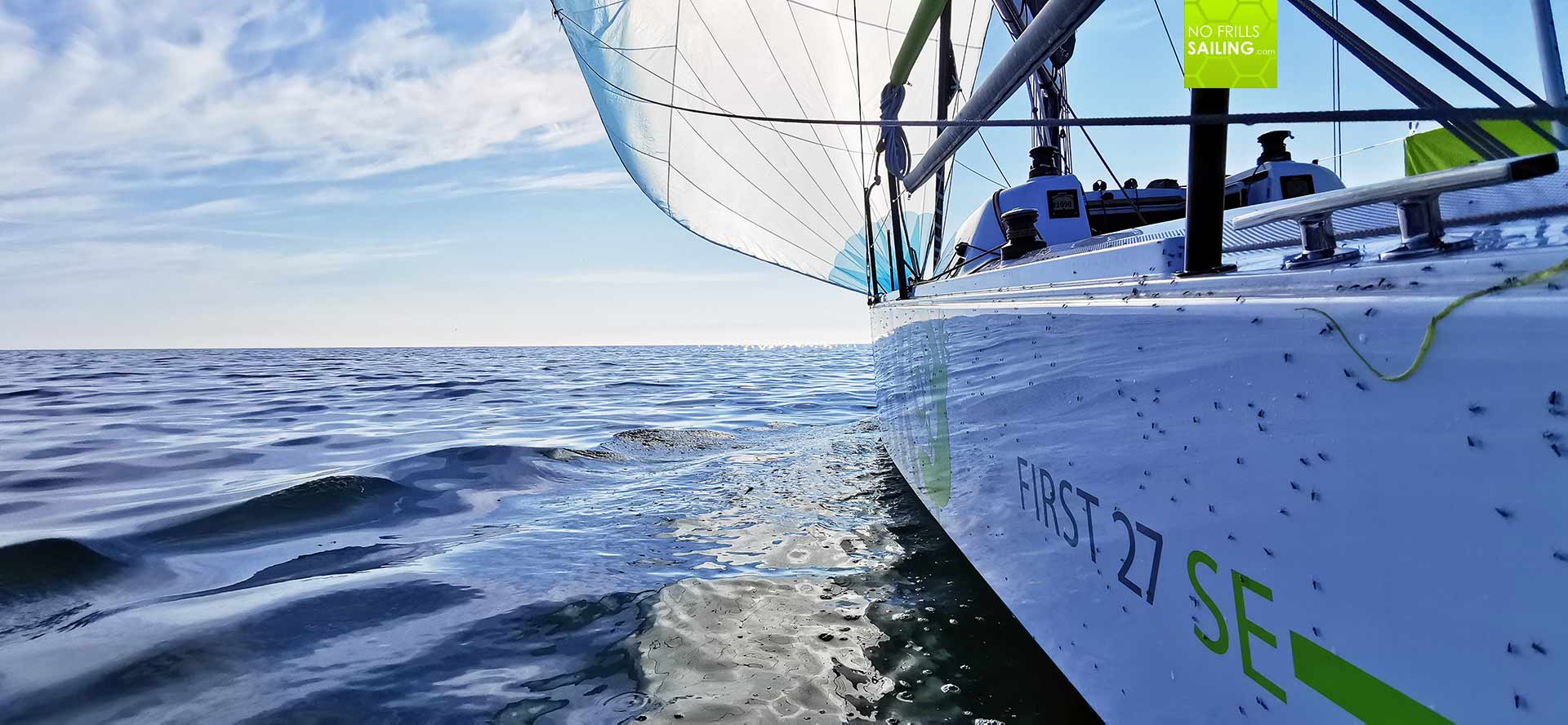
Of course, as the saying goes: “If you share your luck it may double up”, maybe having one more crew member aboard, preferably a female, would have been a lot nicer. Well, not this time, not now. Maiden voyage of GEKKO is reserved for a single handed trip. So far everything went well, every decision I took turned out to be good and since forecast had a complete blackout of wind at 1400, I must say, I made a good progress.
Motoring: An electric engine test
Well, don´t party too fast: At 1015 the logbook notes “Wind died out completely. Switch to electric propulsion”. Well, okay, so let´s have a thorough Torqeedo electric engine test, a matter I had on the list anyways. The big WH 48-5000 battery is set to deliver a load more power than standard batteries and so I of course was keen to see how the engine performs over a long duration. I set the engine, switched to some 2.000 rpm and set a course. After that, I took in the Gennaker and stowed if ready to be hoisted again (which I later did two more times, but only very briefly).
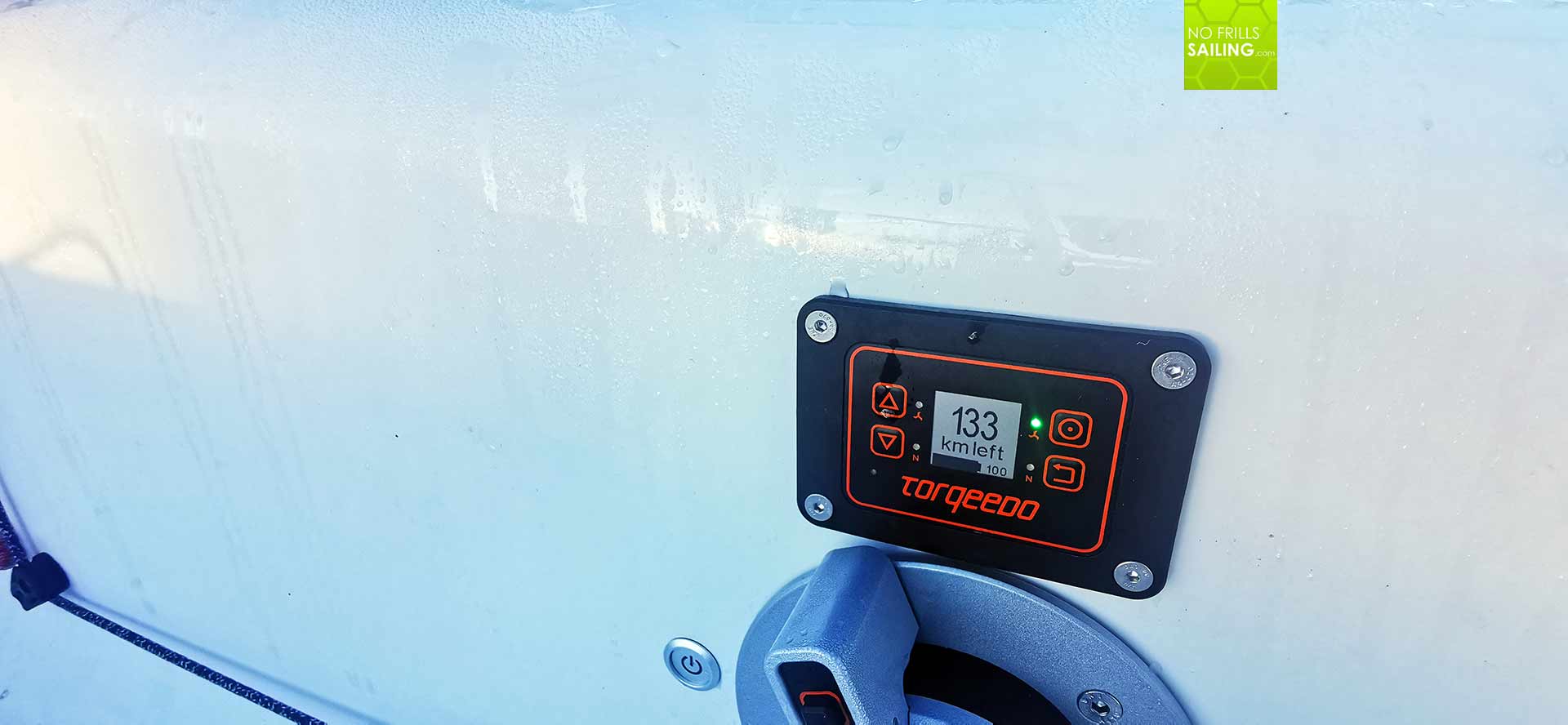
The display showed a 133 kilometres range (well, II haven´t figured out how to switch to miles) which I found rather impressive. Raising the speed of course took down that figure immediately. After adjusting my target speed to 3 knots over ground, which I consider the lowest bearable cruising speed for the best range, the figure changed to 119 kilometres, which is some 65 miles.

Of course, the Torqeedo Cruise 4.0 engine can propel the boat to much faster speeds. But the engine shaft which is under the cockpit of the boat – a specialty of the First 27 SE – creates a vortex that will eat up much of the energy and thus consume ever more power. Increasing speed also means to increase wasted power in the shaft vortex. But 3 knots was okay, considering that it was a test and my target harbor – Kuehlungsborn – was just 20 miles away. I calculated: 20 miles with 3 knots, that’s a 7 hour ride. Well. Sometimes you wish to just get your good old Diesel engine back I guess …
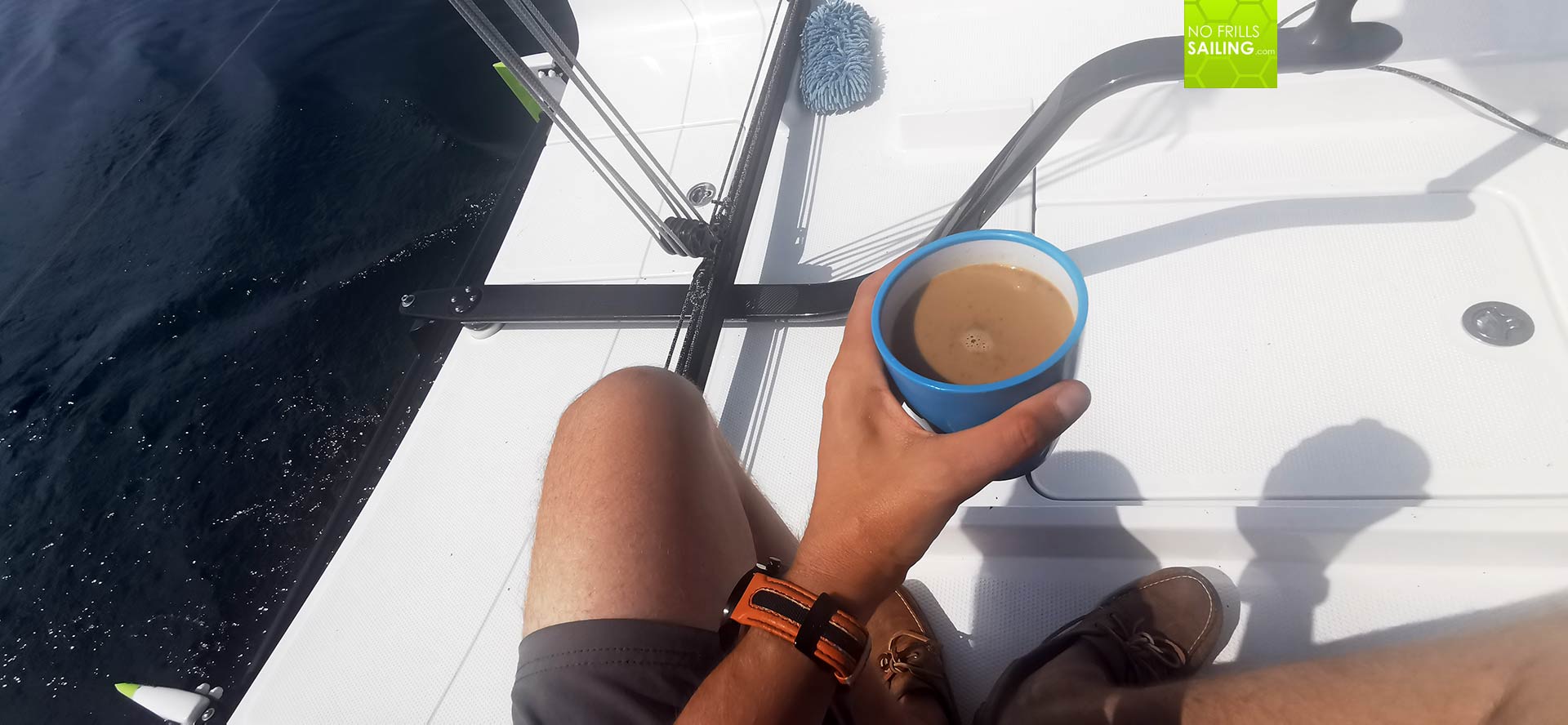
On the other hand, gliding over the water with almost no noise was a treat. When on cruising boats and bigger ships the sound of the engine will be a horror for your ears, on my boat just a slight whizz of the electric engine was recognizable and it did not take away any of the fun and the joy of being out here. Sun was up, well, the flies all around were a bit enervating but I arranged myself, prepared me another cup of coffee and looked at the beautiful coastline slowly going by.
My plan: make no plans!
Well, time went by in slow motion and I loved it. Note to myself: I need to bring a book to the boat. Especially when sailing so slowly, a good piece of literature might be a nice solution. I watched the sea change, fought against the flies on my boat and prepared a nice hot meal. But eventually, after calculating the remaining range which was set at 25 kilometres, I decided not to go to Warnemuende (which was my original plan) because distance was 20 kilometres and … well, maybe the computer in the Torqeedo is not that accurate? So I went to Kuelhungsborn instead, which was a good decision.
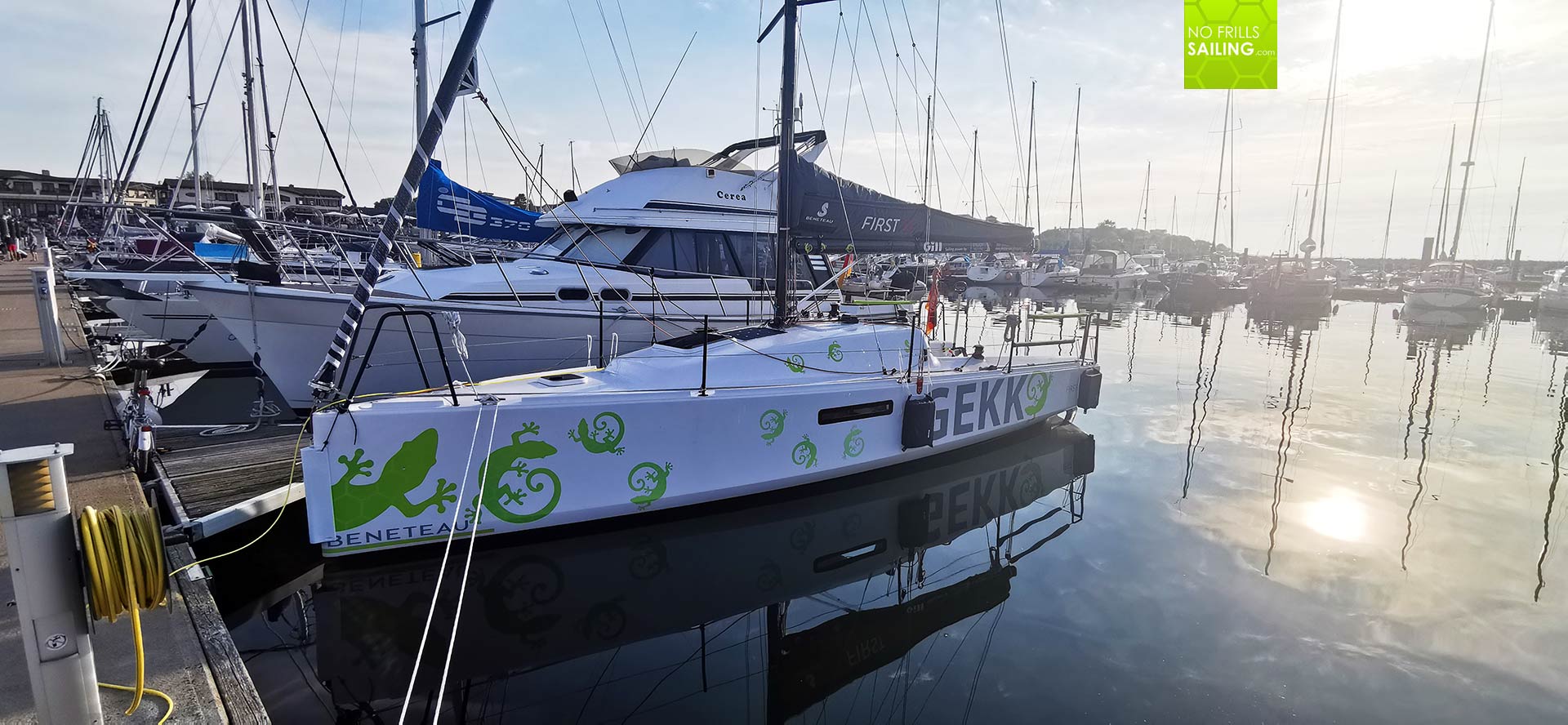
Another learning: No plans! Except for business sailing, like deliveries or handover trips, sailing means working with nature, not against it. I am on that boat for the boat´s sake, for experiencing waves, wind and the seas. It´s not a race, nobody is handing out a reward for reaching a specific harbor. I went into the marina, found a nice berth and landed the boat safely. Greeted by a very nice berth neighbor, GEKKO worked like a magnet and drew some attention of the other sailors on the jetty.
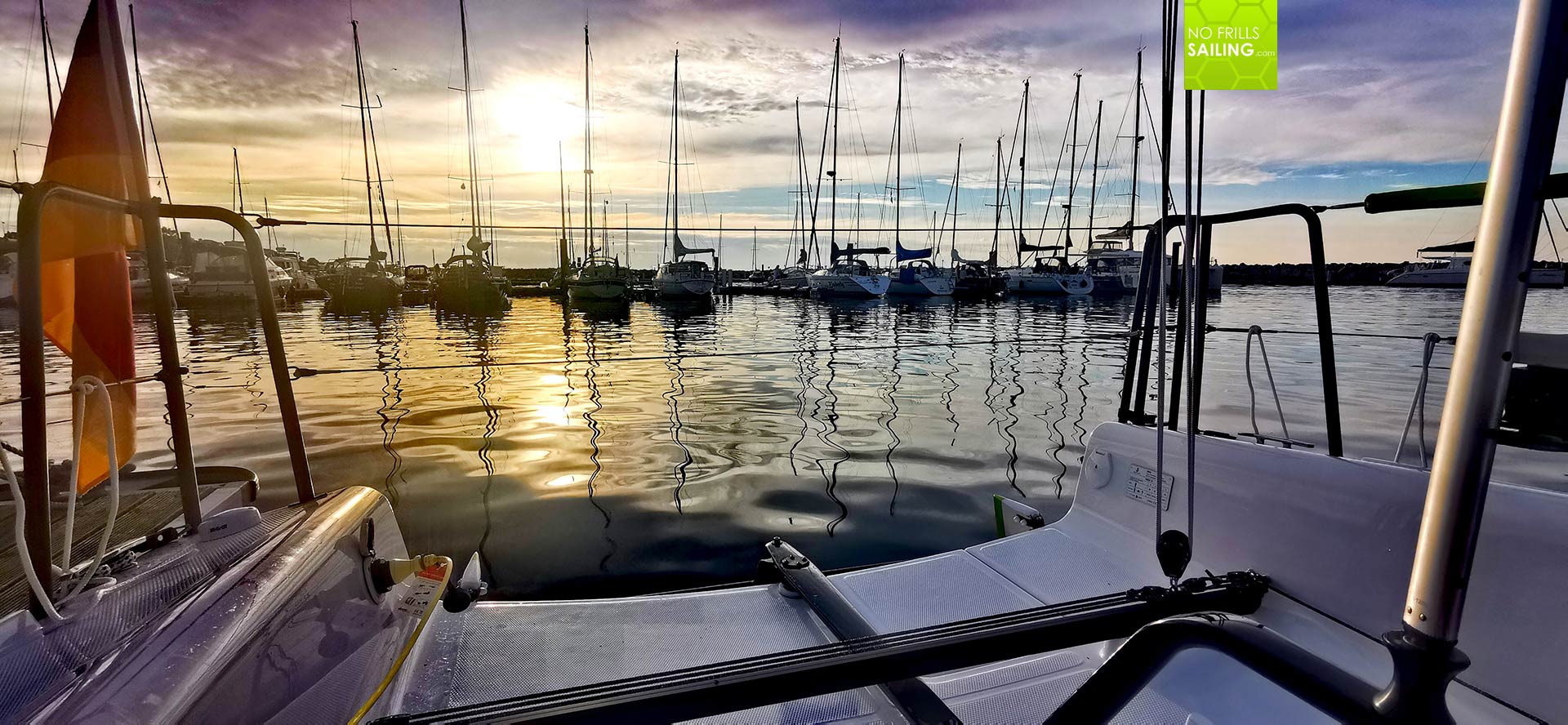
What a great day! “Only” 35 miles done and most of them with electric engine, but I felt calm, relaxed and absolutely down to earth. Taking out the green bean bag, opening a can of fresh cold beer I prepared a nice evening meal and watched the sun go down. In the end, I checked for the logbook the state of my two batteries: After 13 hours of permanent use of power for plotter, autopilot and such the domestic battery was down to 76 per cent. A good outlook: That means I can run two days full power mode switched on before having to recharge. Torqeedo was down to 55 per cent after 10 hours at 3 knots SOG. Also, very impressive figures I´d say.
Baltic Sea from the wild side
The night was calm and I enjoyed it very much. The boat going about gently at her lines and fresh air coming in through the hatches. But the wind increased ever so slightly. Going to bed, the last time I do before switching off my phone is a weather check. I do check for wind, of course, but also temperature and precipitation. For the next day, a remainder of an Atlantic low pressure system was due to arrive with wind of up to 28 knots out on the Baltic Sea, 20 to 24 knots near the coast. So I decided to getting up very early to be out there before the heavy stuff would arrive. Which I did.
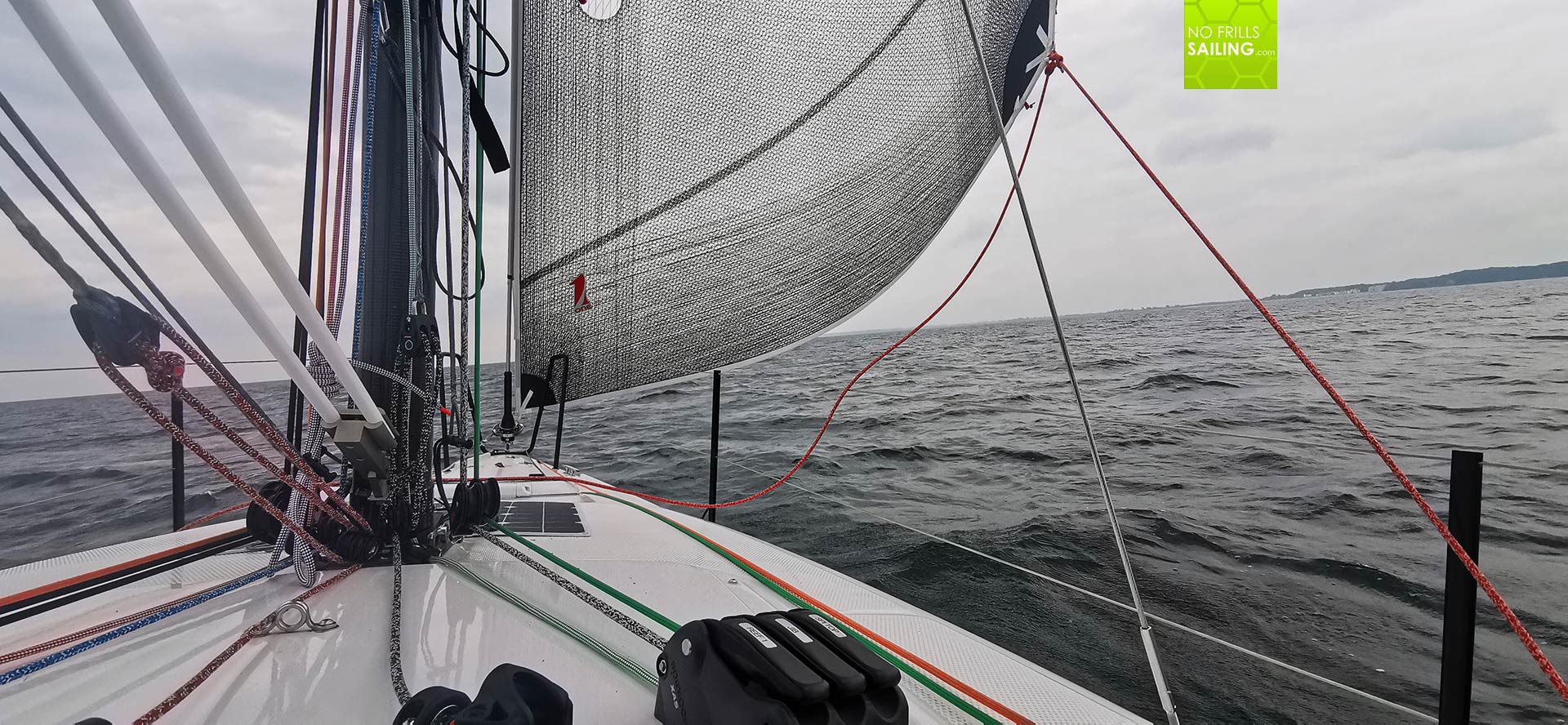
Casting off at 0845 with a nice Westerly blowing at 17 knots TWS I decided not to take up the mainsail. That decision was based on the assumption that the damaged halyard may break apart completely when the sail receives the full pressure of getting hoisted and put up in this wind. Apart from that, running flat downwind the mainsail would block the Genoa anyway from receiving wind., It was a good decision. The boat, although in a pretty rough sea with 1 to 1.20 metres waves from behind, sailed at a steady 6.5 knots pace – surfing down the waves she regularly started to plan, which was amazing!
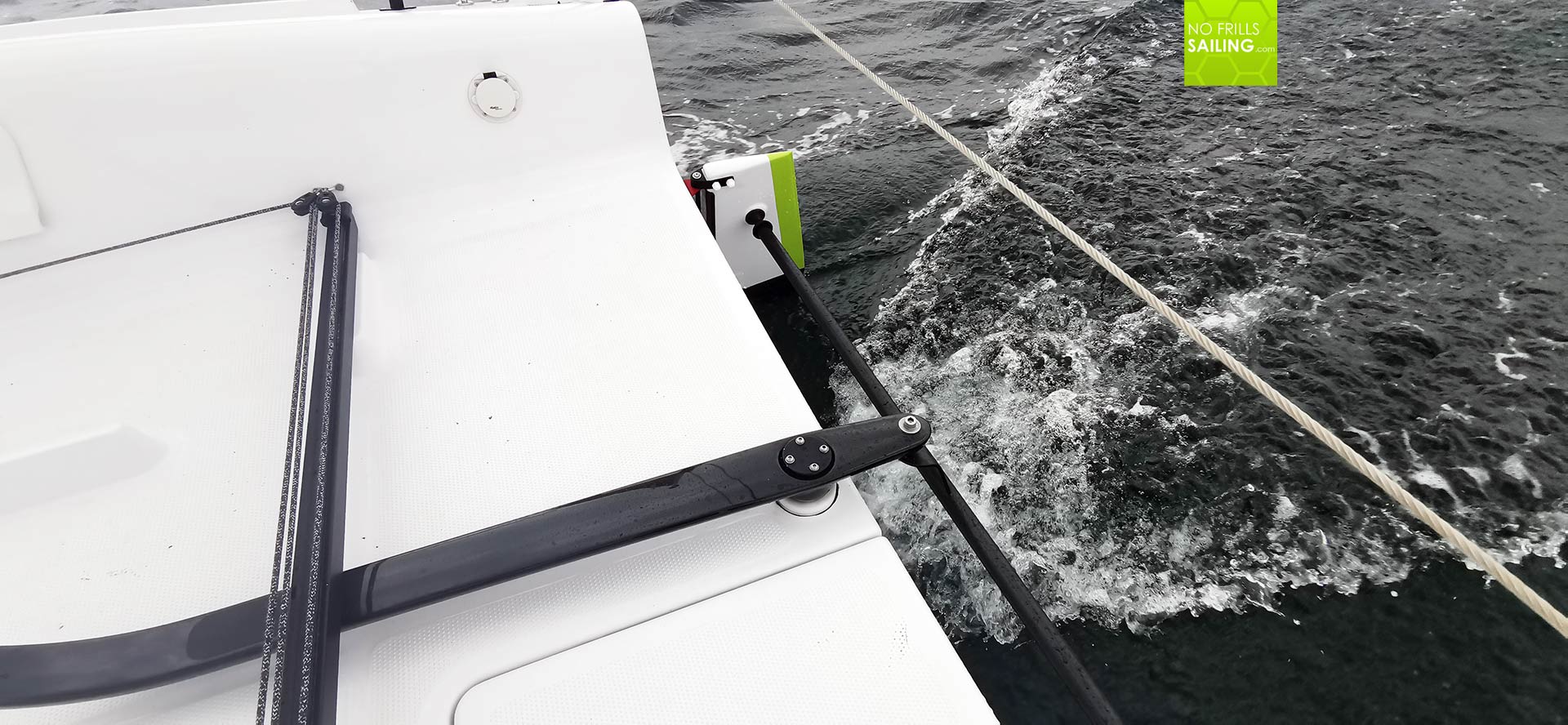
In this I calculated that I would bridge the little more than 10 miles to Warnemuende in just under 2 hours and hoped it would be fast enough to arrive there before the storm would be unfolding its full power. Now, sailing here is a bit tricky as this area is “blocked” by some restricted areas and Cardinal buoys, a ship doing scientific research also demanded one mile distance so I had to perform three or four gybes – which was a no-brainer thanks to Mr. Robot Helsman.
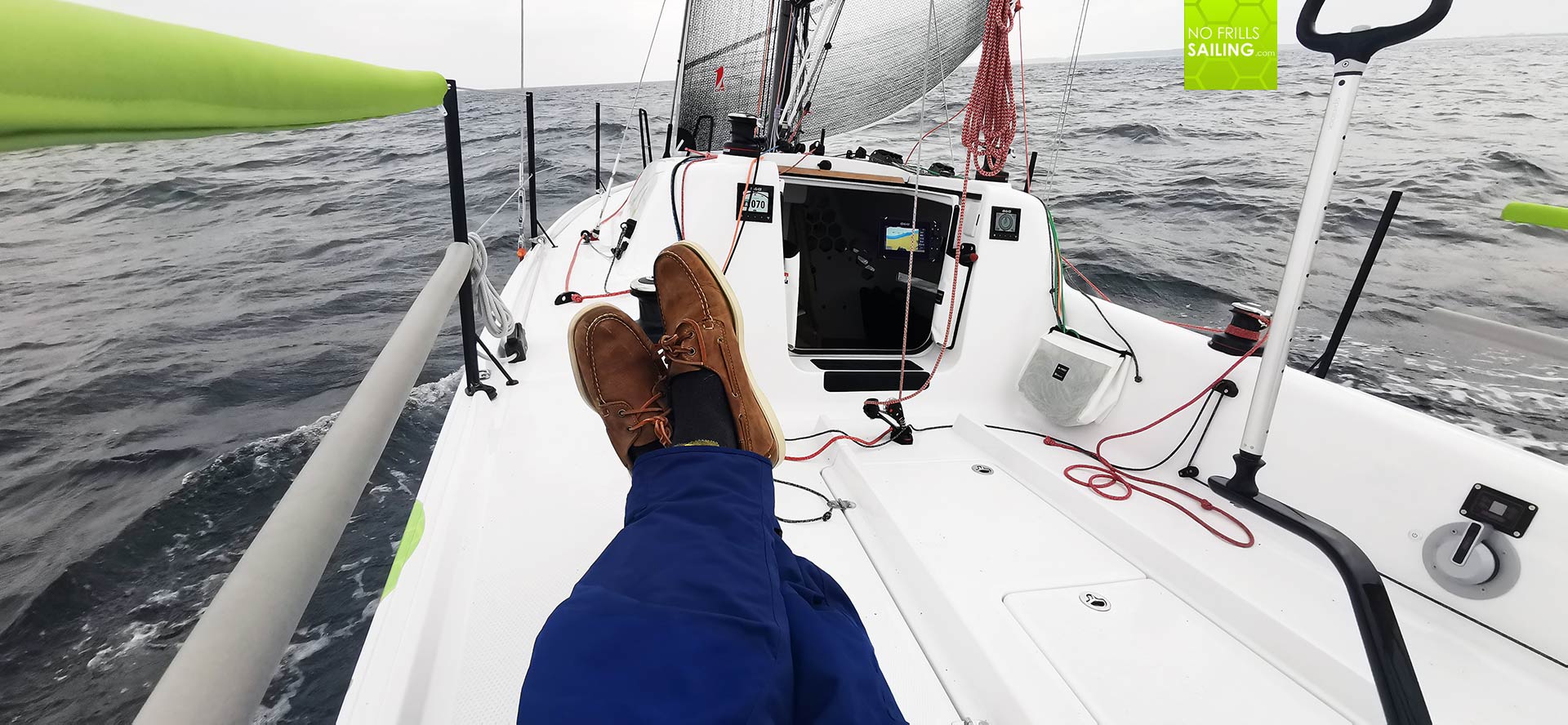
I was happy. Boat going fast (well, not as fast as she would be going under full canvas of course, in these conditions easily +10 knots SOG) but, as I said earlier, single handed first time with a brand new boat your shouldn´t go full throttle right away. A good sailor is a safe sailor. She steered fantastic and the slow I went the day before – the faster it went today.
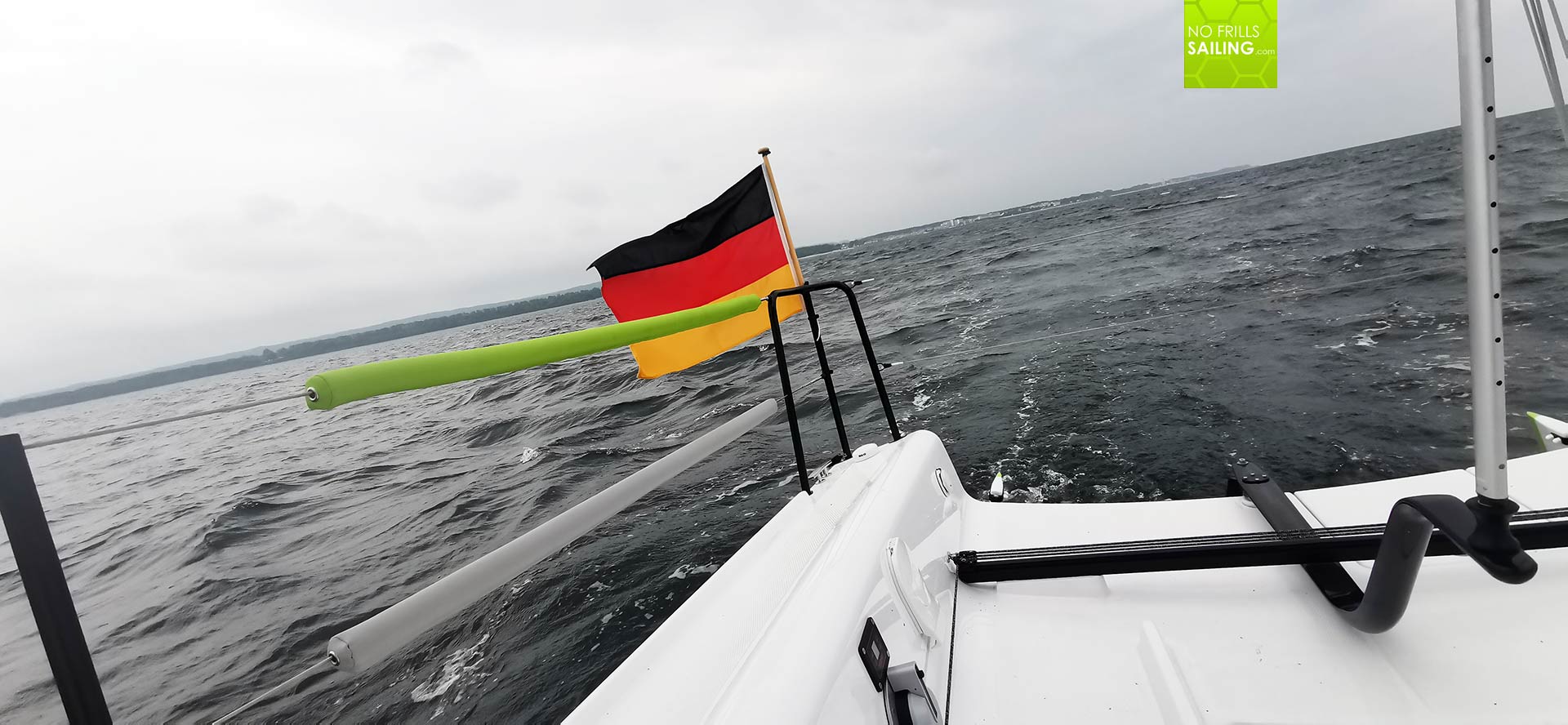
The boat was tumbling in the everbuilding seas, wind speed got up and reached a steady 19 after one hour. I already could see Warnemuende and started to go through the landing process: How will I manage to have this boat landed and tied up safely alone in this wind?
Another mishap to the end
I learned to sail by preventing any stress. Stress for myself, stress for my crew (if there is one), stress for the boat and stress for the others. That said, I always prepare my boat well in advance. I hate going into marinas without all landing lines ready and fenders attached. That creates stress. It will take away attention from what is happening around you. So preventable. So, some 2 miles off the marina, I started to do the fenders, which in this sea state naturally wasn´t so easy. I had them ready at both sides of the boat, with one fender more at starboard, my preferred mooring side when cocking alongside. I also figured that, when going into a box, I would try to moor upwind, so I had the strong lines in the bow, the thinner at the stern.
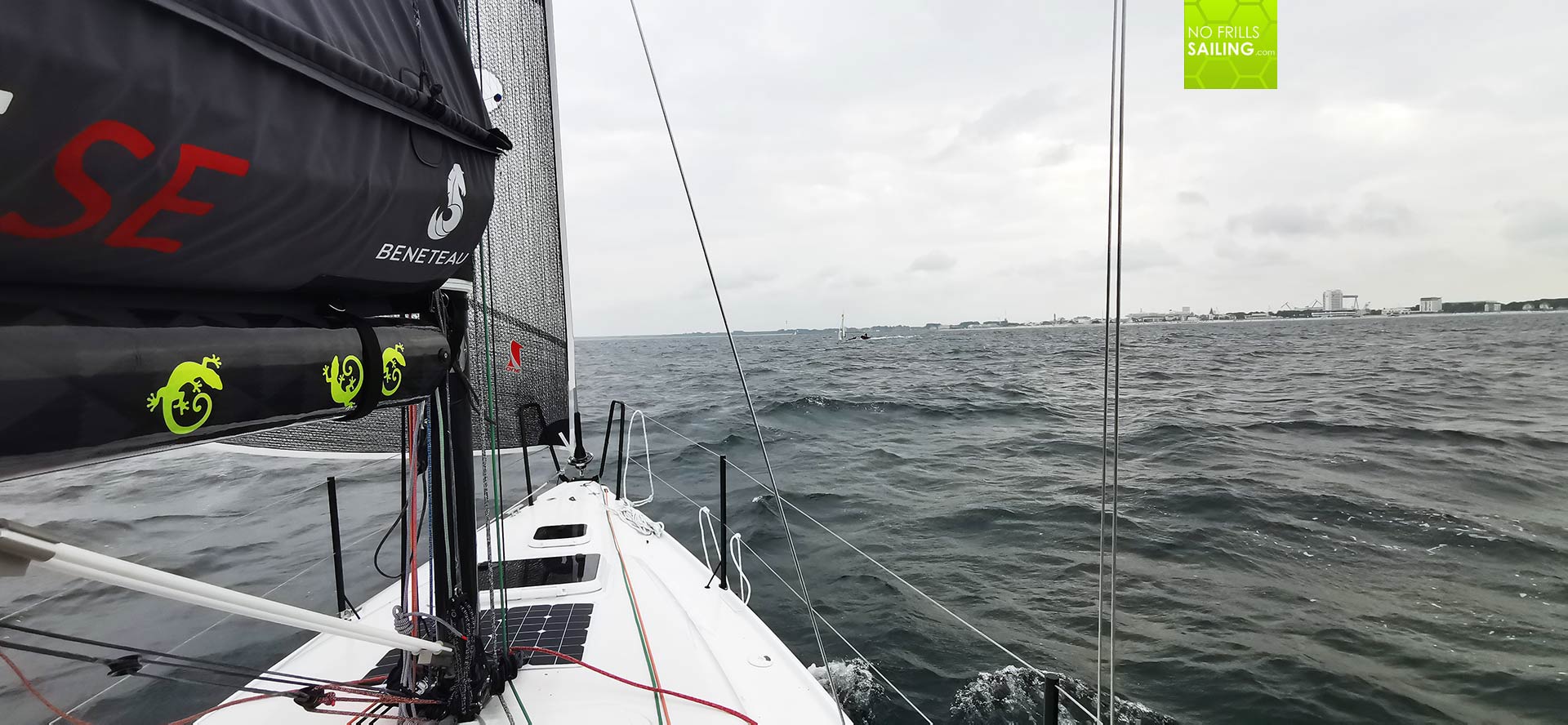
Wind increased steadily, reaching occasional 24 knots. Seas were high as I approached the Rostock breakwater. A 49er boat shot past my bow, underlining the sheer power of the wind now apparent. I took away much of the Genoa sail area so that GEKKO slowed down to 3.5 knots. Then I started to prepare the Torqeedo, which is quite some work – opening the hatches in cockpit, folding out the engine – in a rocking boat not that easy – attaching the safety pin and activating the whole Torqeedo-system.
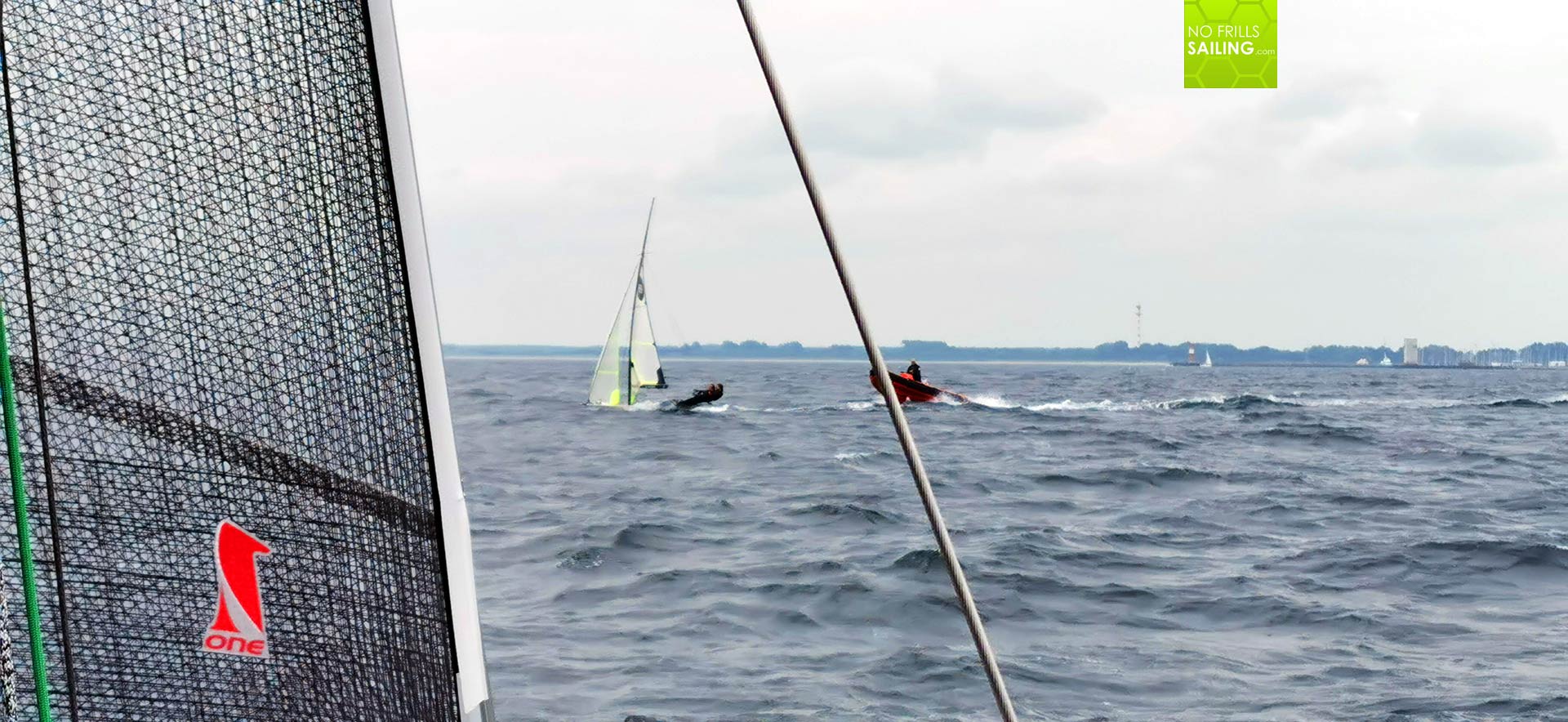
And then the shit hit the fan: The boat dashed downwind with far more than just 4 knots and the Torqeedo – again – had a complete blackout! Error-message on the display, no engine, no power! I cursed, jumped to the reefing line and furled in the Genoa a bit further to reduce speed. I then raced down the companionway to reach for the main switch and killed the whole Torq-system, just to re-start it. In this, my butt killed the main switch on the domestic power panel, deactivating all instruments – and the autopilot as well! Which I at first did not notice. Coming up again, I passed by a fishing boat in 2 metres distance, the fisherman shook his head – I noticed the black displays but had to manually bring her back to course. With the Torq still down and no propulsion, I again killed the system on the switch and re-started it: And then I realized what the error was …

The Torqeedo propeller must not be turning when the system powers up. So you first start the system and then you take down the prop-unit. Well, with entrance of the harbor nearing every second so fast (and it is getting shallow when you miss it even faster) I had no time to take up the whole unit again, so I fell to my knees, bent down and grabbed into the water, stopping the propeller from turning. Then I pressed the Power-button and re-started the third time with now – literally at last second – the system not showing any error message and prop turning.
50 Miles – 50 Learnings
My heart was pounding and I was sweating like hell! Stupid mistake, I critiziced myself! But the critical part wasn´t over yet: In the midst of fighting with my Torqeedo-engine startup procedure I completely forgot the world around me. As I now tried to steam into the marina, I noticed a thick black huge cloud approaching: Thunder and rain. And gusts! I still had domestic battery switched off and quickly re-started the B&G-system as well. Oh boy – 25 knots! And now landing single handedly?!
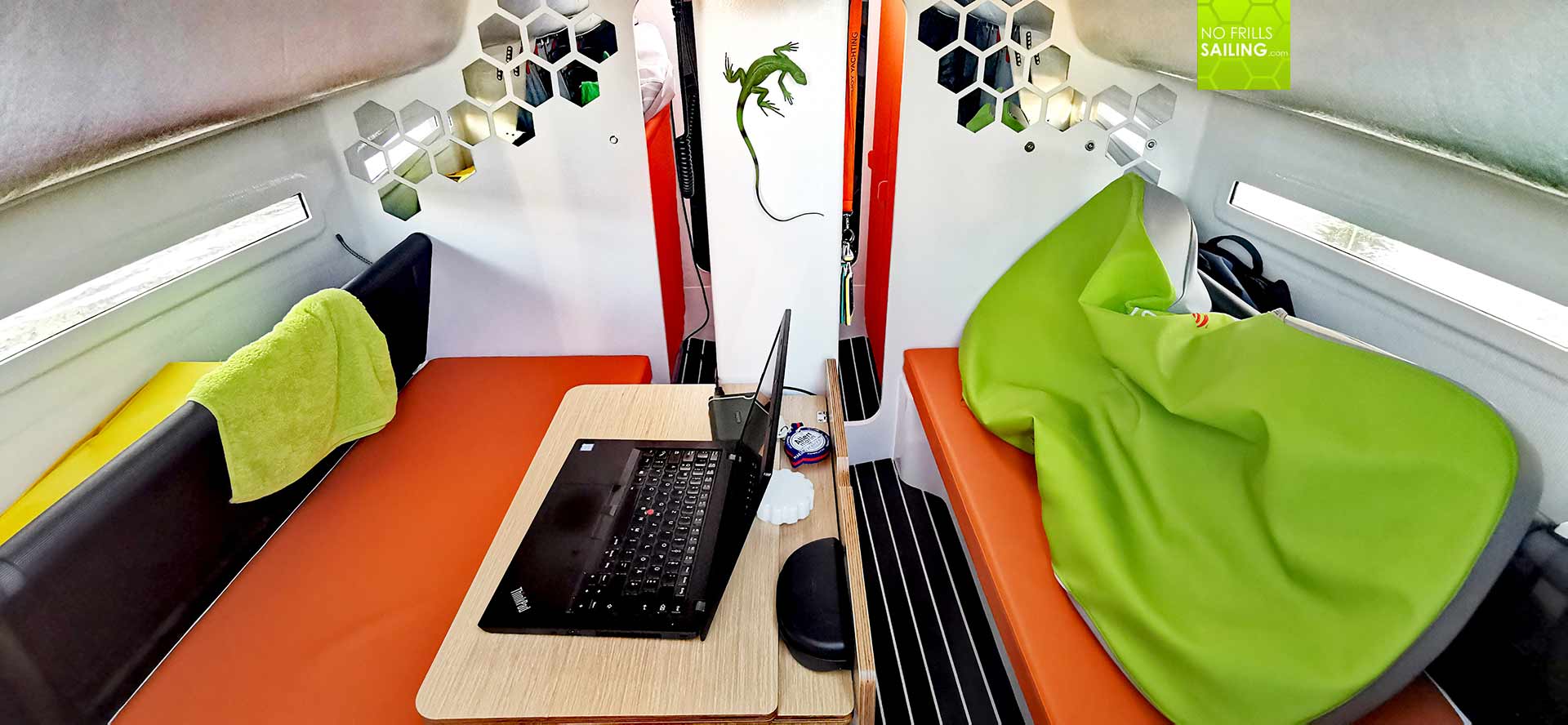
I had to switch to almost full power (the almost full Torq-battery showed “3 km range”) to beat to windward under engine in the marina. The sound of the roaring wind was tremendous. Berthing in a box? Now? Forget it! Lucky me, a head of one jetty wasn´t occupied by a catamaran so I went alongside, stopped and grabbed the bow- and stern-lines. The light boat immediately drifted away and had I been reluctant to jump to the quay one second more I would have landed in the water for sure. It took all my power to hold GEKKO up against the wind and pull her to the quay where I tied her up. Later, after the thunderstorm cloud had passed and wind calmed down to 17 knots briefly, I asked a friend – who – lucky me again! – happened to be present in the marina, helped me to re-locate to a proper berth. Oh boy, what a day!
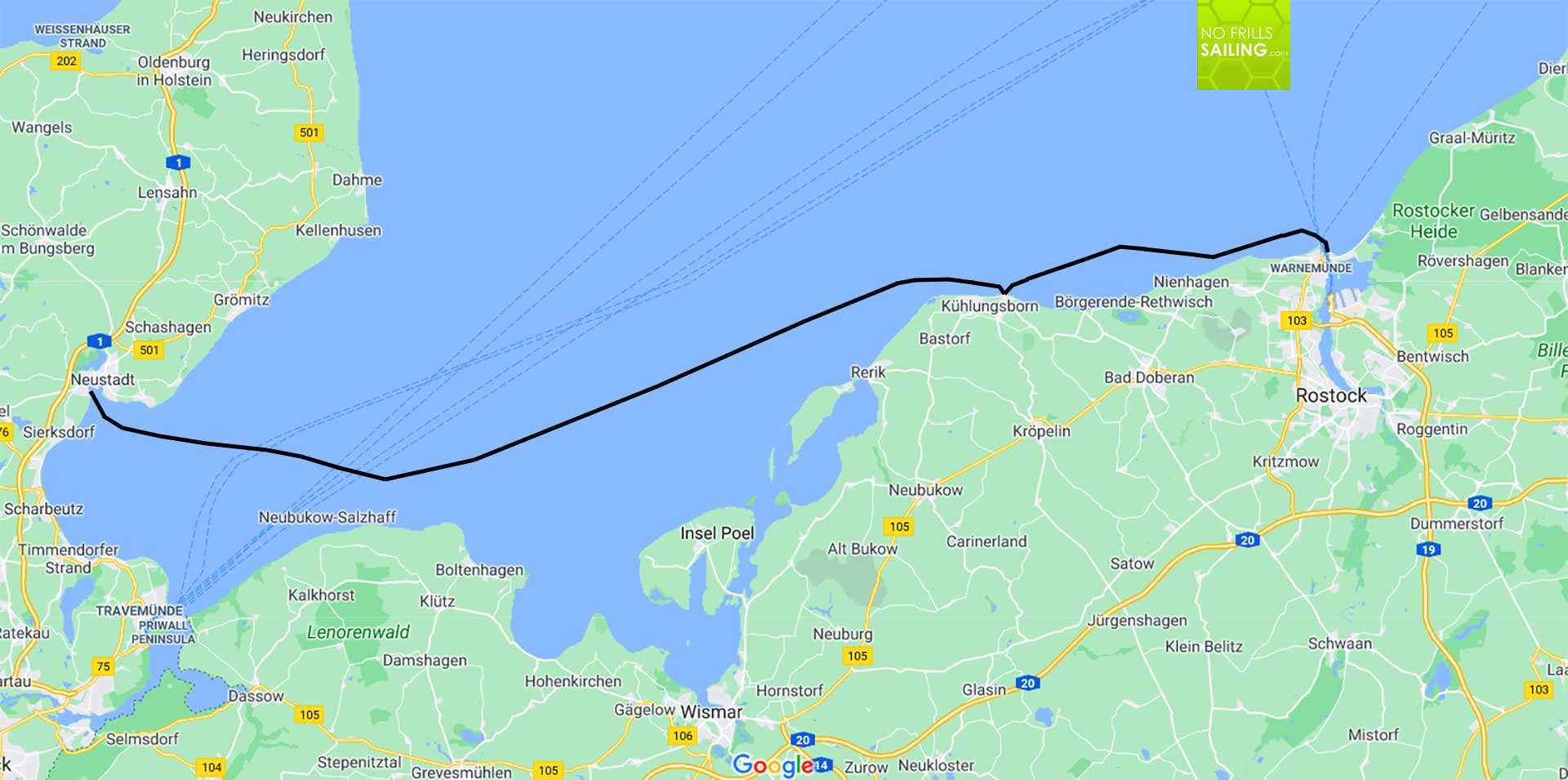
In the end, I had learned so many things during these two first days of GEKKOs maiden voyage: Let loose, don´t push too much and let myself drift by the wind is one. Second is the impressive range of the Torqeedo-engine (at the price of a rather slow speed of course). Third is being a cold-blooded, cool skipper in case of a problem. Handling the Torqeedo-blackout, I´d rate myself a good 80 per cent. Killing the main switch with my butt was stupid, handling the rest of this “crisis” I found myself being pretty cool. Landing alongside first just to have the boat safe at a jetty no matter what was a good decision: Sailing single handed is much, much more complex (in strong winds) than with a second hand aboard. I learned that I should have asked other sailors present in the marina to lend such a helping hand.

Now, sitting aboard, I waited one full day to let the high winds calm down a bit. Yesterday at night the wind was so strong that I felt my body shaking in my berth. Now, it´s 4 o´clock in the afternoon, the wind is down to 15 knots. I will start tomorrow early in the morning. My target? Well, depending: Being able to reach Klintholm which is 50 miles from here would be nice. No matter what, I will see where the wind will blow me to.
You may also love to read these articles:
At Seascape yard in Slovenia
Planning your sailing voyage the old-fashioned way
Weather routing with pro-software
